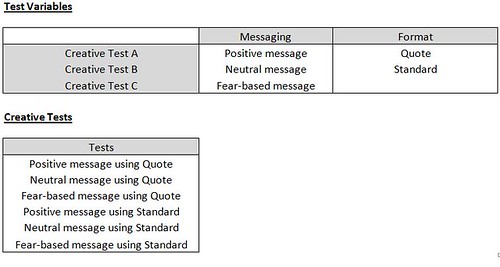Creative testing is broken into five steps:
- Identify test goals
- Identify test themes
- Define and build test structure
- Run test and measure results
- Iterate
We'll talk about each step in more detail in the sections below. Read on to learn more.
Identify Test Goals
The test goals will have a significant impact on how each test will be structured. You may want to know whether one marketing message has more impact than another, or simply build the best possible creative for a certain audience.
Each of these goals will result in different test structures and components. Ideally, you want to begin by defining the goals of a test in objective terms, as these are most easily quantified. For most performance marketers these measures are conversion rate, click-through rate, or return on investment. Examples might include:
- Increase click-through rate by 20% over the current average
- Increase return customer volume by 2% (this may be a combination of creative and media strategy)
- Improve coupon downloads by 15%
Identify Test Themes
Once test outcomes have been reviewed, decide how to best achieve those results. For example:
- Decide on a few interesting ways coupon downloads could be tested including adding an expiration message or adding a possible savings amount.
- Test whether some vendor coupon types are more interesting than others.
- Finally, test whether adding a persona to your text ads (in the form of a quote) or adding display ads (as an image) performs better than none at all.
Don’t be afraid of running some outrageous ideas: A poor performing creative will only live a few days, while a great one can continue to make money for months or years.
Once creative themes are defined, decide how to apply those themes. The consensus across creative testers is that the most impactful elements in a display creative are headline, image, call-to-action, and creative style (which encompasses text fonts, background colors, etc).
The most impactful elements of search creatives are usually headline message, headline type (quote, statistic, etc), main body message, and display URL structure.
For the examples above, tests might include:
- Headlines that test an expiration date for coupons vs. the possible amount saved for coupons.
- Different logo sets (in display) or vendor names (in search) that have different associations with different buyers. For example, test one logo set that conveys luxury against another that conveys savings or low price.
- Different personalities including a cartoon, a woman, and a couple; these can be used as images in display or quotes in search.
Finally, rather than testing just creatives, we always recommend extending the test at least through your landing page. A consistent message is less likely to be jarring to the visitor, resulting in a more accurate reflection of the most effective message.

The ad above is a perfect example of creative-to-landing page optimization. Even the winning dollar amount has increased slightly between the creative click and the landing page arrival. In this case, the user coming from the ad to the landing page is getting exactly what they’re expecting when they click the ad.
Once deciding on what to test and how to want to manage it, the test can be built.
Building A Test
Depending on your goals, your test structure may vary. The most common and easiest format to set up is the A/B test. An A/B test compares the performance of single elements within a creative. This format is great for comparing small tweaks to the same creative or dramatically different variations.

This A/B test focuses on different messaging types for a product. For example, a positive message about a toothpaste brand might emphasize a bright, winning smile while a fear-based message might focus on the likelihood of tooth decay and gum disease if toothpaste is not used.
Note: Any differences between ads will cause Marin to see these ads as distinct for testing purposes. This includes capitalization in headlines.
Multi-variant tests can be used to test multiple elements in the same creative at the same time. These are more difficult to set up, but allow the tester to understand the inter-relationship of different components within a search or display creative. This results in a deeper understanding of which combinations perform best and why.

This multi-variant test focuses on different messaging types and different ways of communicating the message for a product. In addition to testing the message, the format of the message as either a quote from a person or as a standard message is also being tested.
Once variations are built, testing can start.
Running Your Test & Measuring Results
Testing in online marketing can be difficult thing due to traffic volatility. There are a large number of tools that will help measure whether enough impressions, clicks, and conversions are captured to be “significant”.
Marin always recommends using click-to-conversion rate or ROI for most display campaigns and CTR, conversion rate, or ROI for search campaigns. The volatility in the quality of impressions and clicks, particularly with display means that any measure involving impressions is less likely to be repeatable or accurate.
In our experience, assigning both a significance goal and a day count floor (Marin recommends at least a week) is the best way to assure significant results. Make sure that your multi-variate test runs until all variables are considered significant, not just the first one.
Note: Equal rotation for creatives while a test is running is recommended. Frequently, the publishers will reduce traffic much too soon for lower-performing creatives.
Iterate
Testing should never cease. Even your best creative will grow stale over time as views increase and competitors copy your successful ad. Continuous iteration will help you, as a diligent advertiser, stay different and ahead of the competition.